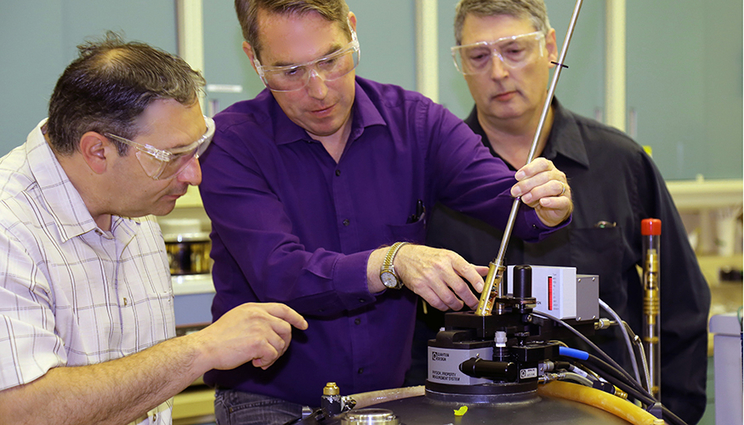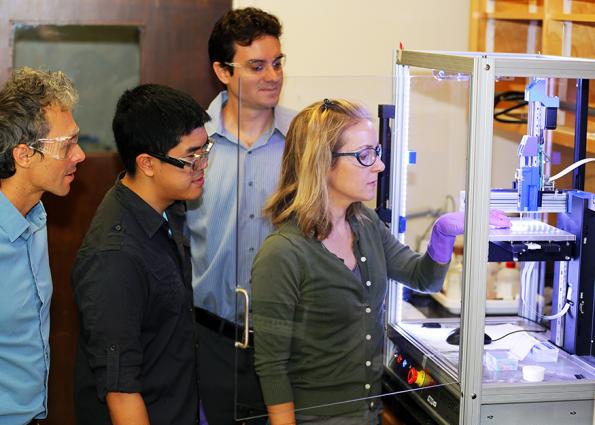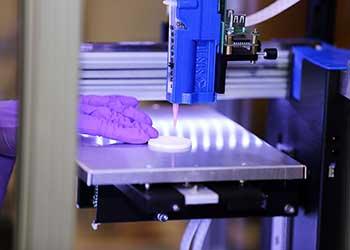Lab wins six DOE commercialization grants
 (Download Image)
Physicists Elis Stavrou, Scott McCall and Harry Radousky (from left) are part of a team of researchers that will explore an additively manufactured process to deposit the thermoelectric layers necessary to produce a functional generator. They are looking at a probe that measures thermoelectric properties. Photos by Carrie Martin/LLNL
(Download Image)
Physicists Elis Stavrou, Scott McCall and Harry Radousky (from left) are part of a team of researchers that will explore an additively manufactured process to deposit the thermoelectric layers necessary to produce a functional generator. They are looking at a probe that measures thermoelectric properties. Photos by Carrie Martin/LLNL
For two years running, Lab researchers have exceeded expectations for capturing Department of Energy (DOE) Technology Commercialization Fund (TCF) grants.
In 2016, the first year of the TCF competition, Rich Rankin, the head of the Lab’s Innovation and Partnerships Office (IPO), expected LLNL might win one proposal. The Lab won two. This year, Rankin and others hoped Lab researchers might win three or four TCF grant proposals. They captured six awards among the selections that were announced Wednesday (Sept.13) by Secretary of Energy Rick Perry.
"To me, this is a significant win for the Laboratory," Rankin said. "We’re excited about this because the TCF investments can help significantly in the commercialization of technology.
"It’s also exciting because the National Nuclear Security Administration (NNSA) invests a great deal of money in our national security missions. These awards show that NNSA investments are yielding dividends for the nation in other areas. Bottom line, everyone in the country relies on and benefits from our nation’s energy systems," Rankin added.
In Rankin’s view, the TCF provides high-impact funding to mature a technology to the point where a potential commercialization partner would be interested in the technology, or on another level, to engage a commercialization partner in steps toward bringing a new commercial product to the market.
"This is a huge benefit in the lab-to-market process because this type of funding is really hard to obtain," he said. "Continued investment in this area can be game-changing."
All six grants are from the DOE Office of Technology Transitions, with five for $150,000 and one for $750,000. The federal grants must be matched with an equal amount of non-federal money, so, as a result, LLNL will provide matches for five of the grants by using IPO licensing and royalty funds.
The LLNL-winning technologies are wide-ranging and include upgrading bio-gas to commercial grade methane, using non-destructive means to test for water entry into solar cells, compressed air energy storage, rare earth element concentration and thermoelectric generation materials. One award supports work on a smart grid simulator tool with a commercial partner.
"The DOE Technology Commercialization Fund provides an opportunity for entrepreneurially minded Lab scientists who have a great idea that addresses an important problem to develop technology with promise for commercialization," said Steve Bohlen, the leader of E Program within the Global Security Principal Directorate. E Program’s research areas encompass energy, cyber and infrastructure security and nuclear materials protection.
"For a lab such as ours, one that is particularly good at generating bench-scale applied technologies, the TCF provides funds to assist with traversing what is really two 'valleys of death' – the first that takes a bench-scale demonstration and matures the technology so that an industry partner is interested in cost sharing further development. The second is the one that takes a technology and connects it with a commercial partner to bring the product to market. The TCF provides opportunities for our scientists to engage in both types of development," Bohlen said.
"The Lab’s success is a tribute to the growing interest in the energy technologies that are being created here and the recognition that our scientists and engineers are finding creative solutions to difficult problems," he added.
The TCF was established by the Energy Policy Act of 2005, which allocated 0.9 percent of DOE’s applied research and development fund for commercialization projects.
Eligible projects can be funded by the DOE offices – the Office of Fossil Energy, the Office of Nuclear Energy, the Office of Electricity Development & Energy Reliability and the Office of Energy Efficiency and Renewable Energy.
Approximately $20 million has been awarded by DOE each year.
The winning technologies are:
Aditive manufacturing of thermoelectric generators: Thermoelectric generators use solid-state conversion of heat to electricity, but are used only in niche waste-heat recovery markets because the cost per watt-hour recovered is too high. A major factor contributing to this cost problem is that commercial thermoelectric generators are manufactured in small, flat-plate modules, making it difficult to thermally couple them to complex-shaped heat sources, such as exhaust systems and steam pipes.
In this work, Lab researchers will explore an additively manufactured process using a supersonic cold-spray technique that sequentially deposits all the conductor and semiconductor layers necessary to produce a functional thermoelectric generator. This approach offers the potential for the large-scale, low-cost, automated fabrication of thermoelectric generator systems directly onto complex-shaped heat sources. The LLNL team is led by Harry Radousky, a physicist in the Materials Science Division of the Physical & Life Science (PLS) directorate. The team’s grant is for $150,000, with a match of $150,000.
Earth battery stores energy using compressed air and heated brine: The Earth battery is being developed by a team of researchers led by Tom Buscheck, an earth scientist in the Atmospheric, Earth & Energy Division of PLS. The goal is to enable increased use of intermittent renewable energy without relying on backup power plants that emit carbon dioxide. It uses porous sedimentary rock, such as sandstone, to store energy when there is too much electricity on the grid, and to return that energy to the grid when there is not enough electricity.
Excess electricity is used to compress air and to heat and pressurize salty groundwater, called brine. Wells, such as those in oil and gas fields, are used to store the air and hot brine underground. When electricity is needed, the pressurized air and hot brine can flow up the wells to generate electricity. The team will use computer simulations to assess the technical feasibility and economic viability of the Earth battery, which will be included in a commercialization plan. The team’s grant is for $150,000, with a match of $150,000.
New materials can reduce methane emissions and produce renewable energy: LLNL researchers have developed a new class of materials, microencapsulated carbon dioxide sorbents, that have the potential for removing carbon dioxide from mixed gas streams. The new materials could provide a more economical route for small facilities to upgrade bio-gas to purity levels that are suitable for injection into the natural gas pipeline network. They also could permit small-scale bio-methane production with a suitable purity for natural gas vehicles.
With a mixture of roughly 60 percent methane and 40 percent carbon dioxide, bio-gas is generated as a byproduct of wastewater treatment and organic waste degradation in landfills. At most small facilities, methane, which is a potent greenhouse gas, is vented or flared. If most U.S. organic wastes were converted to bio-gas and upgraded to bio-methane, they would add significantly to the nation’s electricity.
Lab researchers are planning a one-year project with Delta Diablo’s wastewater treatment facility, with LLNL staff working with the district to collect bio-gas samples that will be tested at LLNL and providing input on meeting end-user technology requirements. Sarah Baker, a materials chemist in the Materials Science Division, leads the research effort. The team’s grant is for $150,000, with a match of $150,000.
Assessment of water ingress impact on photovoltaic modules: A team of LLNL researchers is designing an instrument to gather data about water intrusion into photovoltaic (PV) modules of solar panels. The instrument could then be deployed in a production facility to obtain information about solar modules and materials, along with quantifying the impact of water intrusion on product reliability.
Major PV manufacturers have indicated that expanded technical data about water ingress into solar modules could enable engineers to design solar panels with improved performance and reliability. Water intrusion into PV modules degrades performance through corrosion, mechanical stress and damaging the encapsulating polymer’s optical transmission. Mihail Bora, a physicist in Engineering’s Materials Engineering Division, leads the team’s research, which has received a $150,000 grant with a match of $150,000.
Rare earth element extraction for clean technologies: In recent years, there has been an increasing demand for rare earth elements (REE) for renewable energy, consumer products and defense applications. Lab researchers have developed an innovative biotechnology that relies on bacterial native systems and enhanced bioengineered features to extract and recover REE from low-grade sources.
The United States has an abundance of low-grade REE resources, such as mine tailings, geothermal brines and coal byproducts. While these resources offer a non-traditional alternative for securing REE, no technology exists that can cost-effectively extract REEs from these sources. The project, led by Yongqin Jiao, a microbiologist in the Biosciences and Biotechnology Division, is a collaboration between LLNL and Duke University. The team’s grant is for $150,000, with a match of $150,000.
Simulating the electrical grid of the future with coupled transmission and distribution: The U.S. electrical grid was built for a one-way flow of electricity, produced by large facilities, delivered over miles of transmission lines and distributed to consumers. However, energy sources, such as solar power, are increasingly part of the distribution system. As a result, the smart grid of the future will be an automated system with a two-way flow of electricity.
Current grid simulators can only separately model transmission and distribution. Simulators of the future smart grid must be able to model coupled effects between the transmission and distribution grids. In 2015, LLNL developed ParGrid, a platform for coupled transmission and distribution analysis. With ParGrid, LLNL researchers have demonstrated the potential to conduct analysis for a large-scale power grid, like California’s, which includes 6,000 transmission substations that connect about 10,000 distribution feeders.
In this work, LLNL will collaborate with a leading power management company to integrate the ParGrid platform with the firm’s commercial distribution simulator and LLNL’s open source GridDyn transmission simulator. The project is led by Vaibhav Donde, an electrical engineer in Engineering’s Computational Engineering Division. The grant is for $750,000 and the non-federal match of $750,000 will be funded by the company.
Contact
 Stephen Wampler
Stephen Wampler
[email protected]
(925) 423-3107
Related Links
U.S. Department of Energy Office of Technology Transitions, “Secretary of Energy Rick Perry Announces Nearly $20 Million To HelpTags
Physical and Life SciencesIndustry Collaborations
Technology Transfer
Featured Articles









